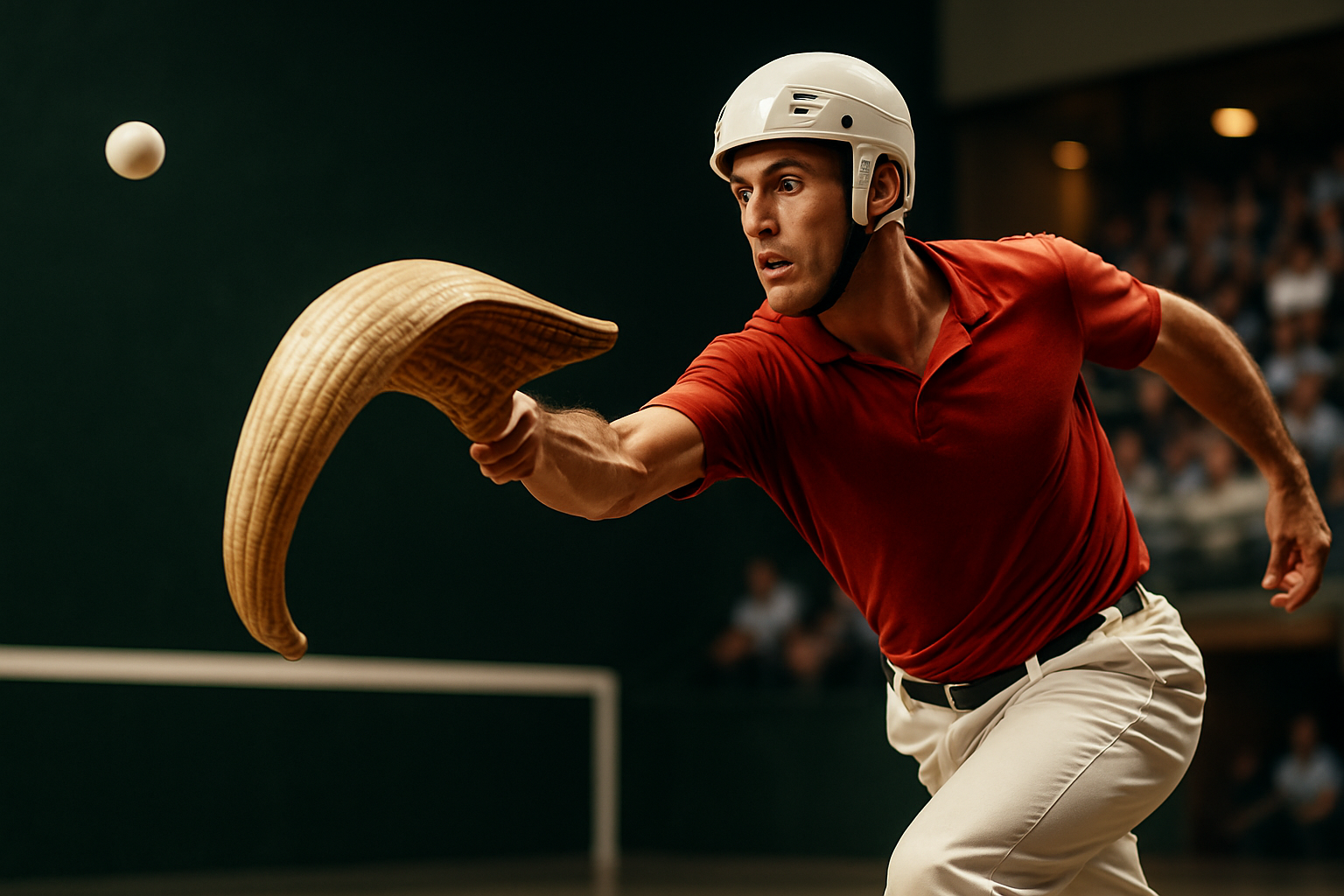Jai-Alai: The Lightning-Fast Basque Pelota Spectacle
The thunderous crack of a wicker cesta meeting a rock-hard pelota echoes through the fronton. Players dart across the court at breakneck speeds, hurling a ball at velocities surpassing 150 mph. This is Jai-Alai, the world's fastest ball game and a thrilling spectacle rooted in Basque culture. Once a dominant force in Florida's gambling scene, this high-octane sport now fights for survival while captivating a new generation of enthusiasts with its raw intensity and rich heritage.

The game’s popularity surged in the Basque Country, with players showcasing their skills in village squares and dedicated frontons. As Basque immigrants spread across the globe, they carried their beloved sport with them, introducing Jai-Alai to Cuba, China, and eventually, the United States.
The unique combination of speed, skill, and danger quickly captivated audiences, leading to the construction of professional frontons in major cities. By the mid-20th century, Jai-Alai had become a sensation, particularly in Florida, where it thrived alongside the burgeoning casino industry.
The Mechanics of the Fastest Game on Earth
Jai-Alai is played on a three-walled court called a fronton, typically measuring 176 feet long, 50 feet wide, and 40 feet high. Players use a curved wicker cesta, ranging from 21 to 28 inches in length, to catch and throw the pelota against the front wall.
The objective is simple: keep the ball in play by catching and throwing it in one fluid motion, ensuring it hits the front wall before bouncing twice on the floor. Points are scored when an opponent fails to return the ball properly or commits a fault.
What sets Jai-Alai apart is the blistering speed of play. The pelota, weighing about 125 grams, can reach velocities of over 150 mph when thrown by skilled players. This makes Jai-Alai not only the fastest ball game but also one of the most dangerous, requiring lightning-fast reflexes and nerves of steel.
The Golden Age of Jai-Alai in America
Jai-Alai experienced its heyday in the United States from the 1960s through the 1980s, particularly in Florida. The sport’s popularity was fueled by a perfect storm of factors: legal gambling, exotic appeal, and the thrill of high-speed action.
Frontons in Miami, Tampa, and Orlando regularly drew thousands of spectators, with the Miami fronton alone attracting over 15,000 fans on its busiest nights. The sport’s popularity extended beyond Florida, with professional frontons operating in Connecticut, Rhode Island, and even Las Vegas.
Jai-Alai players, known as pelotaris, became local celebrities. Many were recruited directly from the Basque Country, bringing an air of international intrigue to the sport. The combination of skill, danger, and the potential for big gambling payouts made Jai-Alai a must-see spectacle for tourists and locals alike.
The Decline and Fight for Survival
The 1990s marked the beginning of a steep decline for Jai-Alai in the United States. Several factors contributed to this downturn:
-
Expanded gambling options: The rise of casino gambling and state lotteries provided new alternatives for bettors, diluting Jai-Alai’s appeal.
-
Player strikes: A prolonged strike in 1988-1989 alienated many fans and disrupted the sport’s momentum.
-
Changing demographics: As the original fan base aged, younger generations showed less interest in the sport.
-
Competition from other entertainment: The proliferation of cable TV and other leisure activities drew audiences away from Jai-Alai frontons.
By the early 2000s, most American frontons had closed their doors. The few remaining facilities struggled to attract crowds and maintain profitability. The sport that once captivated millions now faced extinction in the United States.
A New Hope: Revitalization Efforts and Modern Adaptations
Despite its decline, Jai-Alai has found new champions determined to preserve and revitalize the sport. These efforts focus on adapting Jai-Alai to modern sensibilities while honoring its rich heritage:
-
Modernizing the game: Some frontons have experimented with rule changes to make the sport more accessible and exciting for new audiences. This includes shorter matches and simplified scoring systems.
-
Embracing technology: Live streaming and social media have allowed Jai-Alai to reach a global audience, attracting new fans and rekindling interest among former enthusiasts.
-
Youth programs: Initiatives to introduce Jai-Alai to younger players have emerged, focusing on the sport’s athletic benefits and cultural significance.
-
Diversification: Some facilities have reimagined themselves as multifaceted entertainment venues, offering dining, music, and other attractions alongside Jai-Alai matches.
-
Cultural preservation: Efforts to highlight Jai-Alai’s Basque roots have helped position the sport as a unique cultural experience, attracting history buffs and sports enthusiasts alike.
The Physical Demands and Training of Pelotaris
Jai-Alai players, or pelotaris, are elite athletes whose skills are honed through years of rigorous training. The physical demands of the sport are intense, requiring a combination of speed, agility, hand-eye coordination, and mental fortitude.
Training for Jai-Alai typically begins at a young age in the Basque Country, where the sport remains an integral part of the culture. Aspiring pelotaris start by mastering the basics of catching and throwing with the cesta, gradually building up to the lightning-fast speeds required in professional play.
Key aspects of a pelotari’s training regimen include:
-
Cardiovascular conditioning: Players must maintain exceptional stamina to withstand the constant sprinting and quick changes of direction during matches.
-
Strength training: A strong core, arms, and legs are essential for generating the power needed to hurl the pelota at high velocities.
-
Flexibility and mobility: The ability to contort the body to make difficult catches and throws is crucial for success in Jai-Alai.
-
Hand-eye coordination drills: Pelotaris spend countless hours perfecting their ability to track and control the speeding pelota.
-
Mental preparation: The psychological aspect of Jai-Alai is often overlooked but vitally important. Players must maintain focus and composure in the face of danger and high-pressure situations.
Professional pelotaris often train for several hours a day, six days a week. This intense regimen is necessary to maintain the reflexes and skills required to compete at the highest level of the sport.
The Unique Equipment of Jai-Alai
The equipment used in Jai-Alai is as distinctive as the sport itself, with each piece carefully designed to meet the demands of this high-speed game:
-
The Cesta: This curved wicker basket is the most iconic piece of Jai-Alai equipment. Handcrafted from Spanish chestnut wood and reeds, each cesta is custom-made to fit the player’s hand and playing style. The cesta’s unique shape allows players to catch and release the pelota in one fluid motion, generating tremendous speed and spin.
-
The Pelota: The ball used in Jai-Alai is a marvel of engineering. Its core consists of handwound virgin rubber threads, covered with two layers of goatskin. The pelota is incredibly hard and dense, weighing about 125 grams and measuring just over 2 inches in diameter. This construction allows the ball to maintain its shape and bounce characteristics even when traveling at extreme velocities.
-
Protective Gear: Given the dangers inherent in the sport, pelotaris wear specialized protective equipment. This includes a helmet with a face guard, similar to those used in hockey, to protect against the high-speed pelota. Players also wear padded gloves and may use additional padding on their legs and torso.
-
The Fronton: While not equipment per se, the playing court itself is a crucial element of the game. The three-walled court is typically made of smooth concrete or granite, allowing for consistent and predictable ball rebounds. The front wall features a “falta” line, above which the pelota must strike to be considered in play.
The combination of these specialized tools and the unique playing environment contributes to the thrilling and unpredictable nature of Jai-Alai matches.
The Global Reach of Jai-Alai
While Jai-Alai’s prominence has waned in the United States, the sport continues to thrive in various parts of the world, each region adding its own flavor to this Basque tradition:
-
Spain and France: The Basque Country remains the spiritual home of Jai-Alai, with regular tournaments and a strong amateur scene. The sport is deeply ingrained in local culture, celebrated during festivals and community events.
-
Latin America: Jai-Alai found fertile ground in several Latin American countries, particularly Cuba and Mexico. In Cuba, the sport enjoyed significant popularity until the 1959 revolution, with some efforts to revive it in recent years. Mexico has maintained a small but dedicated Jai-Alai following, with frontons operating in Mexico City and other urban centers.
-
Philippines: Surprisingly, Jai-Alai gained a foothold in the Philippines during the early 20th century. Although gambling on the sport was banned in the 1950s, leading to a decline, there have been recent attempts to reintroduce Jai-Alai as a legitimate sport in the country.
-
China: Jai-Alai was introduced to Shanghai in the 1930s and enjoyed a brief period of popularity. While professional play has ceased, there are occasional exhibition matches and cultural exchanges celebrating the sport’s history in China.
-
United States: Despite its decline, Jai-Alai maintains a presence in Florida and Connecticut. The Magic City Casino in Miami and Dania Jai-Alai in Dania Beach continue to host professional matches, while the sport has found new life through amateur leagues and cultural events in other parts of the country.
This global spread demonstrates Jai-Alai’s enduring appeal and ability to adapt to diverse cultural contexts, even as it faces challenges in its traditional strongholds.
The Role of Gambling in Jai-Alai’s History and Future
Gambling has been inextricably linked to Jai-Alai’s development and popularity, particularly in the United States. This connection has been both a blessing and a curse for the sport:
-
Historical Impact: Legal gambling on Jai-Alai matches fueled the sport’s explosive growth in Florida and other states during the mid-20th century. The potential for big payouts drew crowds and created a thriving ecosystem around the game.
-
Decline and Challenges: As alternative forms of gambling became more accessible, Jai-Alai’s appeal as a betting vehicle diminished. This shift contributed significantly to the sport’s decline in the United States.
-
Integrity Concerns: Like many sports with heavy gambling involvement, Jai-Alai has faced scrutiny over match-fixing and other integrity issues. These concerns have sometimes overshadowed the athletic aspects of the game.
-
Modern Adaptations: Some Jai-Alai facilities have explored partnerships with online betting platforms to reach a wider audience and generate new revenue streams.
-
Focus on Sport vs. Gambling: Many proponents of Jai-Alai argue for a shift away from gambling dependence, emphasizing the sport’s athletic merits and cultural significance.
The future of Jai-Alai may depend on finding a balance between its gambling roots and its potential as a pure sport, capable of attracting fans based on its inherent excitement and skill.
The Cultural Significance of Jai-Alai
Beyond its status as a thrilling spectator sport, Jai-Alai holds deep cultural significance, particularly for the Basque people:
-
Cultural Identity: For the Basque community, Jai-Alai represents a tangible link to their heritage and traditions. The sport embodies values of strength, skill, and communal celebration that are central to Basque culture.
-
Language Preservation: The terminology used in Jai-Alai often includes Basque words, helping to preserve and promote the Basque language, one of Europe’s oldest and most unique linguistic treasures.
-
Diaspora Connections: For Basque communities around the world, Jai-Alai serves as a way to maintain connections to their homeland and pass cultural traditions on to new generations.
-
Artistic Inspiration: The dynamic movements and intense action of Jai-Alai have inspired artists, writers, and filmmakers, contributing to the broader cultural landscape.
-
Tourism and Cultural Exchange: In regions where Jai-Alai is played, the sport can serve as a unique attraction, promoting cultural tourism and fostering understanding of Basque traditions.
By recognizing and celebrating these cultural aspects, proponents of Jai-Alai hope to ensure the sport’s relevance and appeal in the 21st century and beyond.
Innovation and the Future of Jai-Alai
As Jai-Alai faces the challenges of the modern sports landscape, innovators and enthusiasts are exploring new ways to revitalize and reimagine the sport:
-
Virtual Reality Experiences: Some developers are creating VR simulations of Jai-Alai, allowing people to experience the thrill of the game without the physical risks.
-
Mixed Reality Enhancements: Augmented reality technologies could be used to enhance the spectator experience, providing real-time stats and player information during live matches.
-
Sustainable Equipment: Research into eco-friendly materials for cestas and pelotas could make the sport more environmentally conscious and potentially reduce costs.
-
International Collaborations: Cross-cultural exchanges and international tournaments could help broaden Jai-Alai’s appeal and foster a global community of players and fans.
-
Educational Initiatives: Programs that introduce Jai-Alai to schools as part of physical education or cultural studies could help cultivate a new generation of players and supporters.
-
Adaptive Versions: Modified versions of the sport for players with disabilities could make Jai-Alai more inclusive and expand its reach.
-
Data Analytics: Implementing advanced statistics and performance metrics could deepen fan engagement and provide valuable insights for player development.
These innovations, coupled with efforts to preserve the sport’s traditional elements, may hold the key to Jai-Alai’s survival and potential resurgence in the coming years.
Conclusion: The Enduring Appeal of the World’s Fastest Game
Jai-Alai stands at a crossroads, balancing its rich heritage with the need to evolve in a rapidly changing sports landscape. The lightning-fast action, incredible skill, and cultural significance of the game continue to captivate those who experience it firsthand. While challenges remain, the passion of its devotees and the ongoing efforts to innovate and adapt suggest that Jai-Alai may yet find new life in the 21st century.
As the crack of the pelota against the fronton wall continues to echo, albeit in fewer venues than in its heyday, Jai-Alai remains a testament to human athleticism, cultural persistence, and the timeless thrill of sport at its most elemental. Whether as a professional spectacle, an amateur pastime, or a cultural touchstone, the world’s fastest game still has the power to amaze and inspire, ensuring its place in the pantheon of unique and enduring sports.





